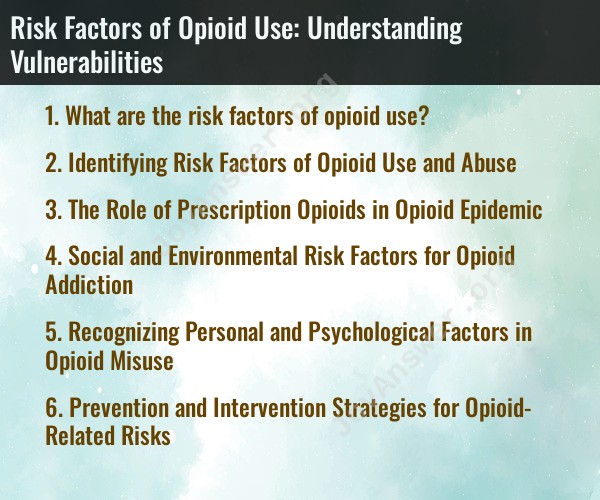What are the risk factors of opioid use?
The use of opioids, whether prescription or illicit, carries inherent risks, and some individuals may be more vulnerable to these risks due to various factors. These risk factors can contribute to the development of opioid use disorders and related issues. It's essential to understand these vulnerabilities to prevent and address opioid misuse and addiction. Common risk factors for opioid use include:
Prior Substance Use: A history of substance use, including alcohol, tobacco, or other drugs, increases the risk of opioid use. People with a pattern of using psychoactive substances may be more likely to misuse opioids.
Mental Health Conditions: Individuals with mental health disorders, such as depression, anxiety, or post-traumatic stress disorder, may use opioids to self-medicate. Opioids can temporarily alleviate emotional distress, but they may lead to dependency.
Chronic Pain: Chronic pain conditions, such as back pain or arthritis, can lead to opioid prescriptions. Prolonged opioid use for pain management may increase the risk of dependence.
Family History: A family history of substance abuse or addiction can be a significant risk factor. Genetic factors may contribute to a predisposition to addiction.
Environmental Factors: Social and environmental factors, including peer pressure, a history of trauma or abuse, and exposure to drug-using social circles, can influence opioid use. A person's social and family environment plays a crucial role in their risk.
Age: Adolescents and young adults are at a higher risk of opioid misuse. Their brains are still developing, making them more vulnerable to the addictive properties of opioids.
Prescription Medication: Individuals prescribed opioids for pain management may inadvertently develop a dependency, especially if they are not adequately informed about the risks and proper use.
Polydrug Use: Concurrent use of multiple substances, including opioids and other drugs, increases the risk of addiction and overdose. Combining substances can have unpredictable and dangerous effects.
Lack of Social Support: Limited social support, such as the absence of a strong family or social network, can make it challenging for individuals to cope with life stressors without turning to opioids.
Economic Factors: Socioeconomic factors, such as poverty and unemployment, can increase the risk of opioid use as a means of escape or coping with life difficulties.
Opioid Availability: Access to opioids, whether through prescriptions, illegal markets, or diversion of medications, can contribute to misuse. Areas with high opioid availability may have higher rates of use.
Prior Substance Abuse Treatment: Individuals who have previously sought treatment for substance abuse or addiction are at risk of relapse, including relapse into opioid use.
It's important to recognize these risk factors and take preventive measures, such as education, early intervention, and access to treatment and support services. Addressing these risk factors and providing alternative pain management options is crucial in mitigating the opioid crisis and promoting public health. Additionally, healthcare providers and policymakers play a significant role in implementing measures to reduce opioid misuse and addiction.
Identifying Risk Factors of Opioid Use and Abuse
There are a number of risk factors for opioid use and abuse, including:
- Personal characteristics: People with certain personal characteristics, such as a history of mental illness, trauma, or substance abuse, are at increased risk for opioid misuse.
- Social and environmental factors: People who live in poverty, have limited access to healthcare, or are surrounded by a culture of substance abuse are also at increased risk.
- Prescription opioids: Prescription opioids are a major gateway drug to opioid addiction. People who are prescribed opioids for pain are at increased risk for developing an addiction.
The Role of Prescription Opioids in Opioid Epidemic
Prescription opioids have played a major role in the opioid epidemic. In the late 1990s, pharmaceutical companies began to aggressively market prescription opioids for the treatment of chronic pain. This marketing led to a dramatic increase in the prescribing of opioids.
However, the medical community underestimated the addictive potential of prescription opioids. As a result, millions of Americans became addicted to prescription opioids.
Social and Environmental Risk Factors for Opioid Addiction
Social and environmental risk factors for opioid addiction include:
- Poverty: People living in poverty are more likely to abuse opioids. This is likely due to a number of factors, including stress, lack of access to healthcare, and exposure to violence.
- Limited access to healthcare: People with limited access to healthcare are more likely to abuse opioids. This is because they may have difficulty getting pain medication from a doctor, or they may be more likely to self-medicate with opioids.
- Culture of substance abuse: People who live in a culture of substance abuse are more likely to abuse opioids. This is because they are more likely to be exposed to opioids and more likely to believe that opioid use is normal.
Recognizing Personal and Psychological Factors in Opioid Misuse
Personal and psychological factors that can contribute to opioid misuse include:
- History of mental illness: People with a history of mental illness, such as depression or anxiety, are at increased risk for opioid misuse. This is likely due to a number of factors, including self-medication, stress, and lack of access to mental health treatment.
- History of trauma: People with a history of trauma, such as physical or sexual abuse, are at increased risk for opioid misuse. This is likely due to a number of factors, including self-medication, stress, and difficulty coping with emotions.
- Family history of substance abuse: People with a family history of substance abuse are at increased risk for opioid misuse. This is likely due to a number of factors, including genetics and environment.
Prevention and Intervention Strategies for Opioid-Related Risks
There are a number of prevention and intervention strategies that can be used to reduce the risk of opioid use and abuse. These strategies include:
- Education: Educating the public about the risks of opioid use and abuse is essential for prevention. Education programs should focus on the dangers of prescription opioids, the signs and symptoms of opioid addiction, and the resources available to help people who are struggling with addiction.
- Treatment: Treatment for opioid addiction is essential for intervention. There are a number of effective treatments available, including medication-assisted treatment and therapy.
- Policy changes: Policy changes can also help to reduce the risk of opioid use and abuse. For example, policies that restrict the prescribing of opioids and that make it easier for people to access treatment can help to reduce the number of people who become addicted to opioids.
By implementing these prevention and intervention strategies, we can reduce the risk of opioid use and abuse and help people who are struggling with addiction to get the help they need.











